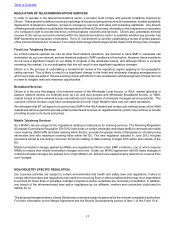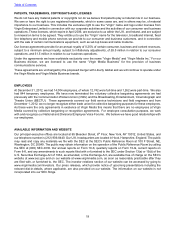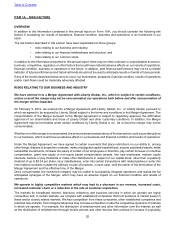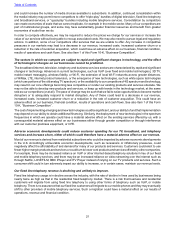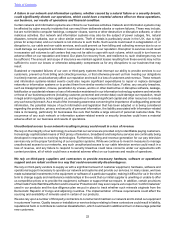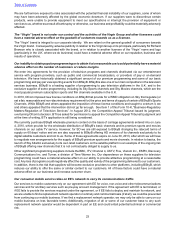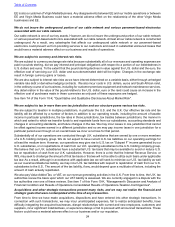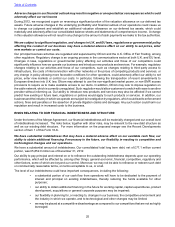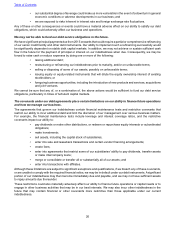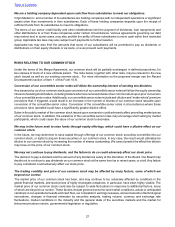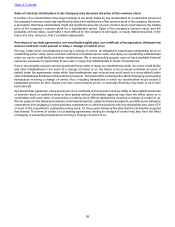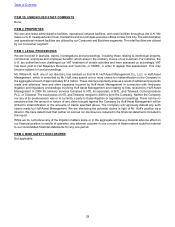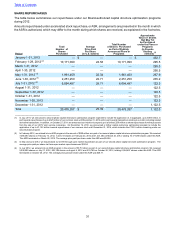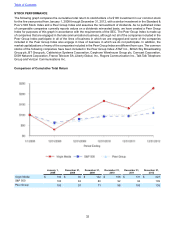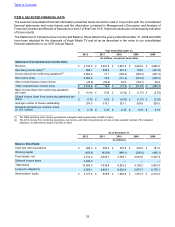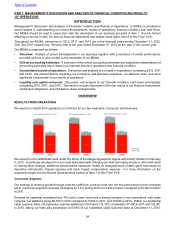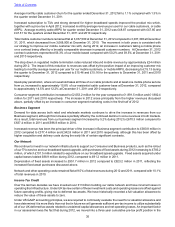Virgin Media 2012 Annual Report Download - page 26
Download and view the complete annual report
Please find page 26 of the 2012 Virgin Media annual report below. You can navigate through the pages in the report by either clicking on the pages listed below, or by using the keyword search tool below to find specific information within the annual report.
25
Adverse changes in our financial outlook may result in negative or unexpected tax consequences which could
adversely affect our net income
During 2012, we recognized a gain on reversing a significant portion of the valuation allowance on our deferred tax
assets. Future adverse changes in the underlying profitability and financial outlook of our operations could cause us
to change our judgment and establish an additional valuation allowance on our deferred tax assets, which could
materially and adversely affect our consolidated balance sheets and statements of comprehensive income. A change
in this valuation allowance will not result in any change to the amount of cash payments we make to the tax authorities.
We are subject to significant regulation, and changes in U.K. and EU laws, regulations or governmental policy
affecting the conduct of our business may have a material adverse effect on our ability to set prices, enter
new markets or control our costs.
Our principal business activities are regulated and supervised by Ofcom and the U.K. Office of Fair Trading, among
other regulators. Regulatory change is an ongoing process in the communications sector at both U.K. and EU level.
Changes in laws, regulations or governmental policy affecting our activities and those of our competitors could
significantly influence how we operate our business and introduce new products and services. For example, regulatory
changes relating to our activities and those of our competitors, such as changes relating to third party access to
infrastructure, the costs of interconnection with other networks or the prices of competing products and services, or
any change in policy allowing more favorable conditions for other operators, could adversely affect our ability to set
prices, enter new markets or control our costs. In particular, following the transposition of recent amendments to
European directives into U.K. law, Ofcom may attempt to use the non-significant market power, or non-SMP, access
provisions to require us to make available access to our ducts. In addition, Ofcom may look to impose regulation on
the cable network, which is currently unregulated. Such regulation would allow customers to switch with ease to another
provider without informing us. Our ability to introduce new products and services may also be affected if we cannot
predict how existing or future laws, regulations or policies would apply to such products or services. In addition, our
business and the industry in which we operate are subject to investigation by regulators, which could lead to enforcement
actions, fines and penalties or the assertion of private litigation claims and damages. Any such action could harm our
reputation and result in increased costs to the business.
RISKS RELATING TO OUR FINANCIAL INDEBTEDNESS AND STRUCTURE
Under the terms of the Merger Agreement, our financial indebtedness will be materially changed and our overall level
of indebtedness increased. The risks below, together with other risks, may be relevant to the new debt structure as
well as our existing debt structure. For more information on the proposed merger see the Recent Developments
section of Item 1 of this Form 10-K.
We have substantial indebtedness that may have a material adverse effect on our available cash flow, our
ability to obtain additional financing if necessary in the future, our flexibility in reacting to competitive and
technological changes and our operations.
We have a substantial amount of indebtedness. Our consolidated total long term debt, net of £77.1 million current
portion, was £5,852.0 million as of December 31, 2012.
Our ability to pay principal and interest on or to refinance the outstanding indebtedness depends upon our operating
performance, which will be affected by, among other things, general economic, financial, competitive, regulatory and
other factors, some of which are beyond our control. Moreover, we may not be able to refinance or redeem such debt
on commercially reasonable terms, on terms acceptable to us, or at all.
The level of our indebtedness could have important consequences, including the following:
• a substantial portion of our cash flow from operations will have to be dedicated to the payment of
interest and principal on existing indebtedness, thereby reducing the funds available for other
purposes;
• our ability to obtain additional financing in the future for working capital, capital expenditures, product
development, acquisitions or general corporate purposes may be impaired;
• our flexibility in planning for, or reacting to, changes in our business, the competitive environment and
the industry in which we operate, and to technological and other changes may be limited;
• we may be placed at a competitive disadvantage as compared to our competitors that are not as highly
leveraged;
Table of Contents




